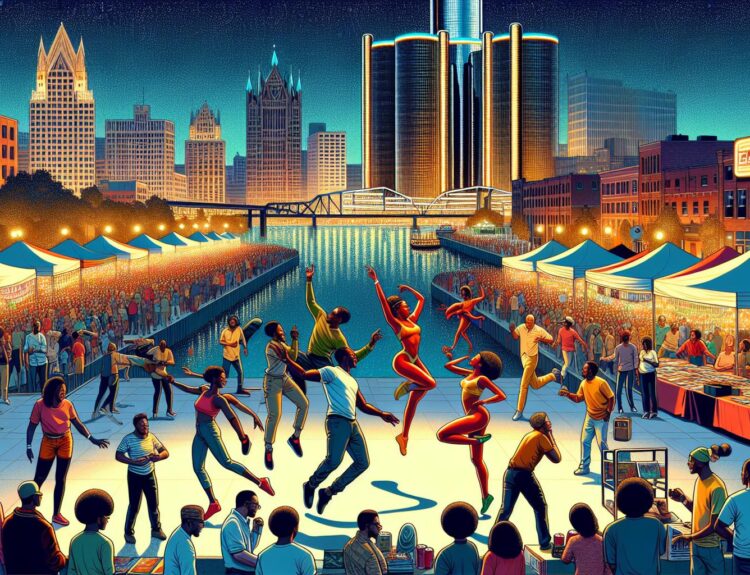Detroit’s architectural heritage is a story of beauty, resilience, and transformation. Walking through the city, I’m always struck by the stunning buildings that tell tales of a glorious past, a challenging present, and a hopeful future.
From the grandeur of the Guardian Building to the modernist marvel that is the Fisher Building, Detroit’s skyline is a testament to the city’s rich history and its indomitable spirit. It’s like stepping into a living museum where every corner holds a new discovery.
Join me as we explore the architectural gems that make Detroit a city unlike any other. It’s a journey through time, art, and the rebirth of an American icon.
The Guardian Building: A Symbol of Detroit’s Art Deco Splendor
When I first laid eyes on the Guardian Building, it was like stepping into an enchanting time capsule that whisked me back to the roaring twenties. This iconic skyscraper isn’t just a part of Detroit’s skyline; it’s a masterpiece that showcases the peak of Art Deco architecture in the city. With its bold colors, geometric designs, and lavish interiors, the Guardian Building is a testament to a period when Detroit was booming, and optimism filled the air.
I remember walking into the three-story, cathedral-like lobby for the first time. My eyes were immediately drawn to the vibrant Rookwood pottery and Pewabic tile that adorn the space. The ceiling, a tapestry of colorful patterns and designs, seemed to tell a thousand stories from a bygone era. It’s easy to see why it’s often dubbed the ‘Cathedral of Finance’; there’s a majestic quality to it that’s both awe-inspiring and deeply humbling.
One can’t discuss the Guardian Building without highlighting its innovative use of color and materials. The exterior, clad in a unique blend of brick and terra cotta, radiates a warm, inviting glow that stands out amidst Detroit’s concrete jungle. It’s this combination of aesthetic beauty and architectural innovation that makes the Guardian Building a true jewel in Detroit’s architectural crown.
The building also played a pivotal role in Detroit’s history, serving as a beacon of hope and resilience during tough times. Its construction during the late 1920s represented a bold statement of confidence in the city’s future, despite the looming economic challenges of the Great Depression. Today, it stands not only as an architectural marvel but as a symbol of the city’s enduring spirit.
Exploring the Guardian Building gave me a deeper appreciation for Detroit’s architectural heritage. Each detail, from the intricate elevator doors to the stunning murals, tells a part of Detroit’s rich story. It’s a place where art, history, and architecture intersect, offering endless discoveries for those who take the time to look closely.
Walking through the halls of this iconic skyscraper, I couldn’t help but feel connected to the city’s past, present, and future. The Guardian Building is more than just an office space; it’s a cultural landmark that continues to inspire and amaze visitors and locals alike. Its enduring beauty and historical significance make it a must-visit for anyone interested in the story of Detroit.
The Fisher Building: Detroit’s Monument to Modernist Architecture
As I continue to explore Detroit’s architectural treasures, it’s impossible not to shine a spotlight on the Fisher Building. Often referred to as Detroit’s largest art object, this skyscraper is not just a building; it’s a testament to the city’s commitment to art and architecture. Designed by Albert Kahn in 1928, it stands as a pinnacle of Art Deco and Modernist design, a beacon in the city’s New Center area.
Walking into the Fisher Building is like stepping into a different era. The three-story arcade, adorned with marble and brass detailing and a ceiling hand-painted with frescoes, takes your breath away. It’s the attention to detail and the lavish materials that make you realize this isn’t just any building; it’s a piece of Detroit’s soul.
Here are some key facts about the Fisher Building:
| Detail | Information |
|---|---|
| Architect | Albert Kahn |
| Year Completed | 1928 |
| Style | Art Deco and Modernist |
| Notable Features | Hand-painted frescoes, marble details |
| Location | Detroit’s New Center area |
What’s fascinating is how the Fisher Building reflects Detroit’s automotive prosperity of the early 20th century. Funded by the Fisher brothers, who made their fortune by selling automotive bodies to General Motors, the building was envisioned as a grand project that would inspire and elevate the city’s profile. And indeed, it did. At the time of its completion, it was the tallest building in Detroit, a symbol of hope and resurgence.
One can’t ignore the Fisher Building’s role in Detroit’s cultural scene. It houses the Fisher Theatre, a hub of performing arts that’s seen everything from Broadway shows to local plays. The building’s tower also serves as a radio broadcast transmitter, further embedding itself into the city’s cultural fabric.
As I roam its corridors, the blend of form and function in the Fisher Building continues to amaze me. Its design not just caters to aesthetic pleasure but also to practical necessities, a true hallmark of Modernist architecture. Each detail, from the lighting fixtures to the door knobs, showcases the era’s unmatched craftsmanship and innovation.
Detroit Institute of Arts: Where Culture and Architecture Meet
As I continued my exploration of Detroit’s rich architectural tapestry, I couldn’t overlook the Detroit Institute of Arts (DIA). Nestled in the heart of the city, this monumental structure isn’t just a museum; it’s a beacon of history, culture, and architectural brilliance. The building itself, a grandiose Beaux-Arts edifice, was designed by Paul Cret and completed in 1927. It holds a special place in the collective heart of Detroit, embodying the city’s resilient spirit and its deep-rooted appreciation for the arts.
Walking through the DIA’s vast halls, I was immediately struck by the intricate details that adorn its walls and ceilings—details that tell stories of dedication, craftsmanship, and an unwavering commitment to beauty. The museum’s exterior, with its white marble façade, stands as a testament to the opulence and grandeur of a bygone era. Yet, it’s the inside that truly captivates visitors. The museum houses over 65,000 works, spanning continents and millennia, making it one of the most comprehensive collections in the United States.
But it’s not just the art that draws people in; the museum’s architectural design plays a crucial role in its allure. The Great Hall, with its vaulted ceilings and ornate columns, creates an atmosphere of reverence and awe. This space, among others within the museum, serves as a reminder of the power of architecture to elevate our experiences and enrich our understanding of history and culture.
| Year Completed | Architect | Style | Collection Size |
|---|---|---|---|
| 1927 | Paul Cret | Beaux-Arts | Over 65,000 |
Moreover, the DIA isn’t static. It’s a living, breathing entity that continues to evolve. Recent renovations have thoughtfully preserved the historical integrity of the building while incorporating modern amenities and expanding its capacity to serve as a cultural hub. These updates ensure that the museum meets the needs of today’s visitors, providing spaces for education, reflection, and community engagement.
Michigan Central Station: From Grandeur to Ruin to Restoration
When I first laid eyes on Michigan Central Station, it was impossible not to be captivated by its towering presence and the stories etched into its walls. Opened in 1913, this Beaux-Arts masterpiece symbolized Detroit’s ambition and growth, serving as a critical transport hub during a time when the city was emerging as an industrial powerhouse. Its grand waiting room, modeled after ancient Roman baths, spoke volumes about the era’s architectural aspirations.
However, as Detroit’s fortunes waxed and waned, so too did the station’s. The decline of the rail industry and the rise of automobile travel gradually sapped Michigan Central Station of its life, leading to its closure in 1988. What followed were years of neglect, during which the building suffered extensive vandalism and decay. It became a haunting relic of Detroit’s past, a symbol of grandeur lost.
The turning point came in 2018 when the Ford Motor Company announced its purchase of the station. This marked the beginning of an ambitious restoration project, not just for the building but for the entire Corktown neighborhood. Ford’s vision entails transforming Michigan Central Station into a hub for innovation and mobility, signaling a new chapter in both the station’s and Detroit’s narratives.
- Structural Repairs: The restoration process began with essential structural repairs to ensure the building’s integrity, including mending the roof and replacing thousands of broken windows.
- Historical Preservation: Efforts are being made to preserve original architectural features, like restoring the ornate ceiling of the main concourse and the iconic clock that once greeted millions of travelers.
- Modern Adaptations: In addition to historical preservation, the restoration includes modern updates to transform the station into a sustainable, green building fit for the 21st century.
This restoration is a testament to Detroit’s resilience and its community’s commitment to honoring the city’s architectural heritage while paving the way for future innovations. Michigan Central Station’s revival is not just about bringing a building back to life; it’s about revitalizing an entire area, encouraging economic growth, and seeding hope in a city ready for its next grand chapter. Such initiatives demonstrate how architecture serves not just as a backdrop to our lives but as an active participant in shaping our future.
Exploring Detroit’s Historic Neighborhoods: A Walk Through Time
As I meander through Detroit, I can’t help but feel enveloped in a rich tapestry of history that each neighborhood tells. My journey through time starts in Corktown, Detroit’s oldest existing neighborhood. Walking along its streets, I’m instantly struck by the vibrant mix of old and new. Here, beautifully restored Victorian homes sit proudly next to modern, hip eateries and boutiques, showcasing the community’s resilience and adaptability. Corktown’s revival, spearheaded by projects like the Michigan Central Station restoration, serves as a testament to Detroit’s dedication to merging its historical roots with contemporary living.
Next, my steps lead me to Brush Park, known as the “Little Paris” of Detroit in the 19th century. This area was once lined with lavish mansions owned by Detroit’s wealthiest citizens. Many of these architectural gems fell into disrepair, but recent efforts have been focused on bringing them back to their former glory, blending them harmoniously with sleek, new developments. The contrast between the ornate, historical homes and the modern condominiums illustrates a conscious effort to honor the past while embracing the future.
My journey wouldn’t be complete without a visit to the Indian Village. With over 350 homes dating from the early 20th century, this neighborhood feels like a step back in time. Each home tells a story, with styles ranging from English Tudor to Romanesque Revival, reflecting the diverse tastes of their original occupants. The meticulous care in preserving these homes highlights a shared commitment among residents to maintain the neighborhood’s historical integrity.
As I wander, it’s clear that Detroit’s neighborhoods are more than just places to live; they are living museums, each with its own narrative contributing to the broader story of the city. From the industrious spirit of Corktown to the elegance of Brush Park and the historical reverence of Indian Village, Detroit proudly displays its architectural heritage. Restoration efforts across these areas not only respect the past but also look forward to a future where history and progress walk hand in hand.
Walking through these neighborhoods, I’ve come to appreciate the layers of history that build upon one another, creating a rich, dynamic fabric that is uniquely Detroit. It’s a city that doesn’t shy away from its past but instead uses it as a foundation upon which to build a vibrant and hopeful future.
Conclusion
I’ve always been fascinated by the way cities evolve and Detroit’s journey through its architectural heritage is no exception. Exploring Corktown, Brush Park, and Indian Village has been like walking through a timeline of design and innovation. It’s clear that Detroit isn’t just holding onto its past; it’s weaving it into the fabric of its future. The city’s dedication to restoring its beautiful neighborhoods while integrating modern elements is truly inspiring. I’m left with a deep appreciation for Detroit’s unique blend of history and progress. Here’s to the Motor City, where every street tells a story and every building is a testament to resilience and renewal.






